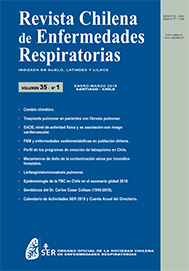Epidemiological situation of tuberculosis in Chile, 2018
##plugins.themes.bootstrap3.article.main##
Abstract
The first High Level Meeting of the General Assembly of the United Nations on ending Tuberculosis was performed in September 2018. In the meeting, the Member States subscribed new commitments and goals for 2022. In Chile in 2017, the tuberculosis incidence rate increased to 15.6 cases per 100,000, with important heterogeneity within geographic regions. Specific tuberculosis mortality rate remains stable, reaching 1.2 per 100,000 in 2016, also with heterogeneity within regions. Among the cases diagnosed in 2017, the most frequent risk group was the elderly (21.4% of cases), followed by foreign migrants (15.5%). In the same year, 37 cases of TB-MDR/RR (multidrug-resistant and Rifampicin-monoresistant TB) were diagnosed, and this number has grown steadily during the last 5 years. Treatment outcomes of the 2016 new cases cohort are as follows: 78.9% completed treatment, 10.5% deceased, and 6.6% lost to follow-up. Results in previously treated patients, HIV-TB co-infected patients, and TB-MDR patients, are significantly worse. The household contacts investigation coverage was 86.4% in all age, and 91.8% in under 15 years old. Tuberculosis remains a relevant public health issue in Chile and globally. The international tuberculosis agenda was reactivated in 2018, and this involved the generation of new global commitments in order to accelerate the accomplishment of the global goals in the End TB Strategy.
##plugins.themes.bootstrap3.article.details##
Tuberculosis, Public Health, Incidence, Risk factors, HIV infections, Multidrugresistance, United Nations

This work is licensed under a Creative Commons Attribution-NonCommercial 4.0 International License.







